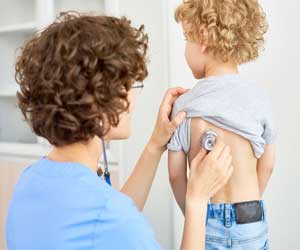- Home
- Editorial
- News
- Practice Guidelines
- Anesthesiology Guidelines
- Cancer Guidelines
- Cardiac Sciences Guidelines
- Critical Care Guidelines
- Dentistry Guidelines
- Dermatology Guidelines
- Diabetes and Endo Guidelines
- Diagnostics Guidelines
- ENT Guidelines
- Featured Practice Guidelines
- Gastroenterology Guidelines
- Geriatrics Guidelines
- Medicine Guidelines
- Nephrology Guidelines
- Neurosciences Guidelines
- Obs and Gynae Guidelines
- Ophthalmology Guidelines
- Orthopaedics Guidelines
- Paediatrics Guidelines
- Psychiatry Guidelines
- Pulmonology Guidelines
- Radiology Guidelines
- Surgery Guidelines
- Urology Guidelines
Eosinophil derived neurotoxin may be a potential biomarker for wheezing-associated disease

Korea: Elevated serum eosinophil-derived neurotoxin (EDN) levels may cause wheezing episodes in children after respiratory tract infection (bronchiolitis, childhood asthma, and allergic rhinitis), suggests a recent study in the Journal of Asthma.
This is the first study to examine high serum eosinophil-derived neurotoxin in relation to wheezing episodes after a respiratory infection.
Wheezing is the high-pitched whistling sound made during breathing. It is quite common with pre-school children. Young children with wheezing require ED visits and hospitalizations at much higher rates than older children and adults.
Eosinophil-derived neurotoxin is associated with recurrent wheezing episodes after bronchiolitis, childhood asthma, and allergic rhinitis. Hanna Kim, School of Biological Sciences, Immunology, UC Berkeley, Berkeley, California, US, and colleagues investigated if there is a measurable difference between serum EDN levels in children with wheezing and non-wheezing respiratory infections.
The study included 171 children who visited a university hospital with respiratory infections. They were divided into two groups; wheezing (n = 46) and non-wheezing (n = 125), Serum EDN levels, assayed by K EDN ELISA Kit, were then compared between the two groups.
Also Read: Children without allergies can still be afflicted with asthma-like coughing and wheezing
Key findings include:
- Serum EDN levels in the wheezing group (48.8±71.4 vs 13.3±5.1 ng/mL) were significantly higher than in the non-wheezing group.
- The non-wheezing group was divided into three sub-groups: pneumonia, common cold, and tonsillitis.
- Serum EDN levels in the wheezing group were significantly higher than in pneumonia, common cold, or tonsillitis subgroups.
- There was no significant difference in serum EDN levels among pneumonia, common cold, and tonsillitis subgroups.
Also Read: Narrow-spectrum antibiotics better in children with respiratory infections: JAMA
"These findings suggest that elevated serum eosinophil-derived neurotoxin levels could be a distinctive feature of respiratory infections with wheezing. EDN’s utility as a biomarker for the wheezing-associated disease should be explored through further study," concluded the authors.
To read the complete study log on to https://doi.org/10.1080/02770903.2019.1642349

Disclaimer: This site is primarily intended for healthcare professionals. Any content/information on this website does not replace the advice of medical and/or health professionals and should not be construed as medical/diagnostic advice/endorsement or prescription. Use of this site is subject to our terms of use, privacy policy, advertisement policy. © 2020 Minerva Medical Treatment Pvt Ltd